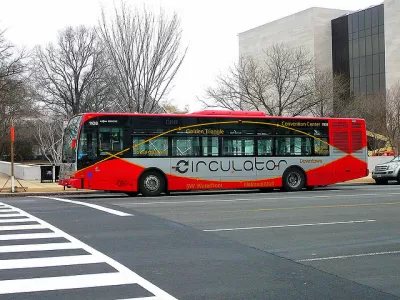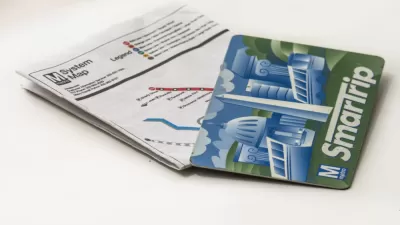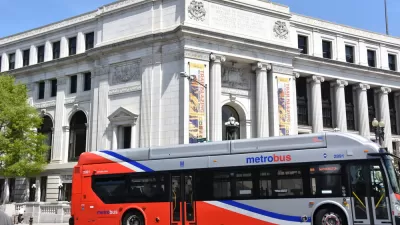The D.C. Circulator is struggling with maintenance costs and system performance. The balkanization of local bus systems in the region might be to blame.

Dan Malouf explains the effects of the balkanization, or fragmentation, of bus systems in the Washington, D.C. region.
So, there are "more than 20 separate bus providers in the Washington area. WMATA is the largest and covers the most territory, but most counties and large cities have their own," according to Malouf. "DC has Circulator, Montgomery has Ride On, Arlington has ART, etceteras."
It's the financial woes of the D.C. Circulator, reported by Martin Di Caro in May, that inspires Malouf's explanation. In fact, writes Malouf, the "situation suggests some of the thinking behind balkanization of the Washington region's bus network may be faulty."
The bulk of Malouf's analysis drills down on the inadequacies of how local bus operators measure the costs of operation. While the WMATA's Metrobus costs $142 per hour to operate, Fairfax County Connector runs at $104 an hour, ART runs at $72 an hour, and the DC Circulator runs at $83 an hour. However, as Malouf notes in detail, if the math looks too good to be true, it probably is.
FULL STORY: DC Circulator woes show why local buses can’t always replace Metrobus

Maui's Vacation Rental Debate Turns Ugly
Verbal attacks, misinformation campaigns and fistfights plague a high-stakes debate to convert thousands of vacation rentals into long-term housing.

Planetizen Federal Action Tracker
A weekly monitor of how Trump’s orders and actions are impacting planners and planning in America.

In Urban Planning, AI Prompting Could be the New Design Thinking
Creativity has long been key to great urban design. What if we see AI as our new creative partner?

King County Supportive Housing Program Offers Hope for Unhoused Residents
The county is taking a ‘Housing First’ approach that prioritizes getting people into housing, then offering wraparound supportive services.

Researchers Use AI to Get Clearer Picture of US Housing
Analysts are using artificial intelligence to supercharge their research by allowing them to comb through data faster. Though these AI tools can be error prone, they save time and housing researchers are optimistic about the future.

Making Shared Micromobility More Inclusive
Cities and shared mobility system operators can do more to include people with disabilities in planning and operations, per a new report.
Urban Design for Planners 1: Software Tools
This six-course series explores essential urban design concepts using open source software and equips planners with the tools they need to participate fully in the urban design process.
Planning for Universal Design
Learn the tools for implementing Universal Design in planning regulations.
planning NEXT
Appalachian Highlands Housing Partners
Mpact (founded as Rail~Volution)
City of Camden Redevelopment Agency
City of Astoria
City of Portland
City of Laramie





























